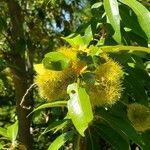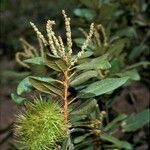Trees or erect shrubs , to 45 m. Bark thick, rough. Twigs densely covered with tight, yellowish, peltate trichomes. Leaves: petiole 5-8 mm. Leaf blade flat or folded upward along midvein, margins entire, apex acute or acuminate, surfaces abaxially usually golden or brownish with dense glandular trichomes. Fruits: cupule yellowish, 20-60 mm thick, densely spiny, surface obscured; nut light brown, (6-)8-12(-15) mm, glabrous, completely enclosed by cupule until maturity.



